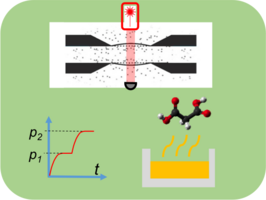Contact:
Associate Professor Aurélien Dantan
(dantan@phys.au.dk, +4587155676, 1522-424)
Bachelor/master projekter: se matchmaking poster eller kontakt Aurelien
This project, funded by Villum Fonden, aims at answering the question: How accurately can one measure low gas pressure in a simple and absolute manner? To attempt to answer it, optomechanical pressure sensors, based on nanoguitars—consisting in highly tensioned strings sculpted on ultrathin dielectric drums—will be realized with the goal of performing absolute pressure measurements with sensitivities beyond the state-of-the-art by monitoring the pressure-induced modifications of the string vibrations (frequencies, damping) with a laser.
In addition to providing a possible new metrological standard for the absolute determination of pressure, the proposed sensors will be applied to the determination of the saturation vapor pressure of environmentally relevant particles, for which the group has recently developed a dedicated instrument (ASVAP).
This project, funded by Novo Nordisk Fonden, aims at the realization of ultrasensitive and versatile optomechanical sensors for gas detection, pressure sensing, optofluidics and quantum technologies. Such sensors will consist in arrays of nanostrings (nanoguitar) sculpted on ultrathin dielectric drums using nanolithography techniques in order to tailor their optical and mechanical response. The vibrations of the resonators, highly sensitive to e.g. gas pressure change or molecule adsorption, will be monitored optically.
The project is based on very recent breakthroughs realized by the group regarding the design, fabrication and application of nanostructured silicon nitride thin films. It will aso involve collaboration with both local and international groups, as well as with a Canadian company, world leader in the fabrication of silicon nitride membranes.

A key parameter for describing the partitioning of chemical substances at interfaces like air-water or air-aerosols is the saturation vapor pressure of a given substance, i.e. the pressure of the substance above a liquid or solid surface of the pure substance at a given temperature at equilibrium. Current state-of-the-art instrumentation in physical chemistry and atmospheric science does not allow the measurement of saturation vapor pressures in the relevant low-volatility range in a unified, direct and efficient way.
This interdisciplinary project, funded by IRFD-FTP and carried out between IFA (Aurélien Dantan, Henrik B. Pedersen) and the Chemistry department (Merete Bilde), proposes to solve this fundamental measurement problem by building a novel instrument exploiting state-of-the art micromechanical sensors, interferometry, ultrahigh vacuum technology, and aerosol sample preparation and handling. In addition to providing highly valuable data for environmental science databases and modelling, the instrument’s potential as a new standard tool will be benchmarked by complementary chamber and spectroscopy experiments.
This project, funded by the Danish Council for Independent Research, aims at developing ultrashort optical resonators composed of ultrathin, nanostructured vibrating mirrors for various sensing applications. By patterning thin suspended silicon nitride films with a subwavelength structure (high contrast grating) and assembling them to form micron-long optical cavities, highly wavelength-selective optomechanical sensors operating in a new regime will be realized. The high spectral selectivity combined the small cavity modevolume and the outstanding mechanical quality of the vibrating mirrors will be exploited for various sensing applications and for fundamental investigations of optical forces at the nanoscale.
This project, funded by Villum Fonden, aims at developing and characterizing novel electro-opto-mechanical components in which the vibrations of high-quality mechanical resonators (silicon nitride membrane drums) can be activated by both optical and electrical fields. Such on-chip integrated platforms will find applications in signal processing and sensing at low-power levels – e.g. for realizing optical switches, delay lines, microwave-to-optical transductors for telecommunications and metrology – and will allow for investigating fundamental physics using arrays of coupled quantum oscillators.
This Villum Fonden-funded project aims at investigating phonon dynamics in optomechanical arrays of nanomembranes. Tensioned membranes made of silicon nitride and only tens of nanometres thick represent excellent nanomechanical resonators for optomechanical investigations. Amongst their virtues are their low effective mass (nanograms) and thickness, their record mechanical quality factors of several millions, and their ultralow absorption, which facilitate their integration in high-finesse optical resonators. The radiation pressure forces exerted by optical fields on periodic arrays of such membranes allows for engineering long-range effective interactions between the vibrational modes of the individual membranes. Such interactions will be exploited to study collective optomechanical phenomena, such as synchronization, and non-equilibrium thermodynamics in few-element systems.
Project description
This project aims at engineering novel optomechanical systems composed of thin, movable membranes positioned in the field of an optical resonator and investigating the effects of the radiation pressure exerted by the cavity light on the motion of the membranes, as well as the back-action of their motion onto the light, at the quantum level. The excellent optomechanical properties of these nanomembranes should make it possible to explore new regimes of optomechanics in which effects due to the quantized nature of the motion and the light could be observed and exploited.
Ultimately, these membranes are to be integrated in a cavity ion-trap system, such as the ones developed in the Ion Trap Group in Aarhus (http://phys.au.dk/forskning/forskningsomraader/amo/the-ion-trap-group/), in order to perform hybrid optomechanics experiments in which a well-controlled atomic system, such as a cloud of trapped, laser-cooled ions, can be made to interact with macroscopic mechanical oscillators.
Such optomechanical interfaces, which potentially combine optical, mechanical and electrical activations of thin mechanical oscillators, would have applications in metrology, photonic and quantum information processing sciences, as well as surface and nano-sciences.
This project is funded by a Sapere Aude forskningsleder grant from the Danish Council for Independent Research.
Contact person: Aurélien Dantan (dantan@phys.au.dk, +4587155676, 1522-424)
Project start: Dec. 1st 2012
